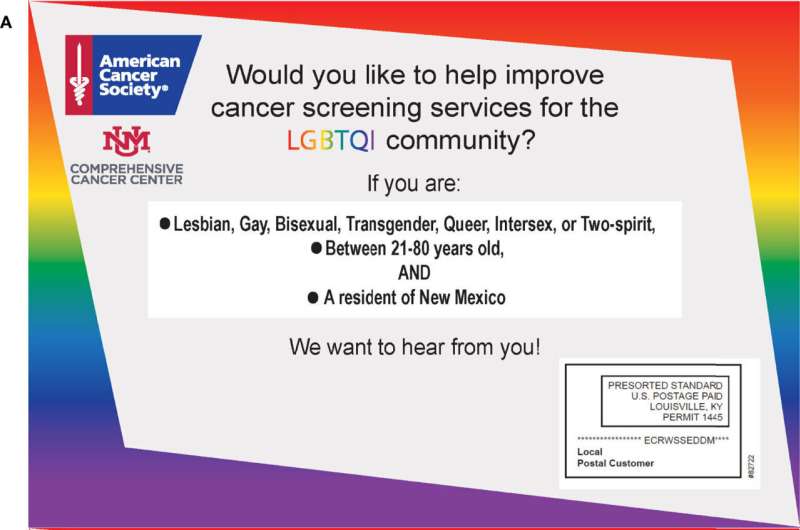This article has been reviewed according to Science X's editorial process and policies. Editors have highlighted the following attributes while ensuring the content's credibility:
fact-checked
trusted source
proofread
Cancer screening in LGBTQIA+ individuals

Prajakta Adsul, MBBS, Ph.D., MPH, saw the void in 2018 when she worked at the National Cancer Institute and helped the United States Preventive Services Task Force develop guidelines for cervical cancer screening.
"When reviewing the evidence," she says. "There was no data about cancer screening in LGBTQIA+ individuals. At that moment, I realized it was a gap in our cervical cancer prevention research. We have to do better."
After joining The University of New Mexico Comprehensive Cancer Center in 2019, Adsul learned about LGBTQIA+ communities in New Mexico through her interactions with fellow cancer scientist, Miria Kano, Ph.D. That learning inspired her to start filling the LGBTQIA+ void in cancer research. But she faced a daunting challenge: how to reach these seemingly hard to reach people during a pandemic?
"I am a recently naturalized citizen of [the United States of] America, and I am a cis-gender, heterosexual person," Adsul says. "For me to learn about the LGBTQIA+ community and to understand barriers to health care faced by the community was a steep learning curve. I was committed to learning in a sensitive and appropriate manner while being respectful of the community's strengths."
Guided and supported by her research team, Adsul discovered that LGBTQIA+ people—just like any other group of people—are not so hard to reach if you learn how to reach them, at least in New Mexico.
Crafting the survey questions for LGBTQIA+ communities was the most important task, because the LGBTQIA+ spectrum comprises many subgroups. The survey questions had to be posed appropriately and in a way that heeded nuances in terminology and understanding.
The questions were adapted from the Stanford PRIDE study questionnaires, and the researchers also sought input from several resources such as the National Academies' Measuring Sex, Gender Identity, and Sexual Orientation and the UNM Health Sciences Library's LGBTQIA+ Health Resources online guide.
Adsul's research team, including Kano, Molly McClain, MD, and Emily Wu, MD, then partnered with a marketing team affiliated with the United States Postal Services, and used a combination of mailed flyers and social media to reach LGBTQIA+ people. Their strategy included direct mail, social media posts and digital advertising, and it focused on reaching rural areas of New Mexico, not just metro areas.
"We sent out 27,000 flyers and made around 430,000 impressions online," Adsul says. And, she says, McClain and Wu personally handed out flyers and talked to their patients about the research.
The carefully and sensitively worded survey questions yielded an overwhelmingly positive response from the New Mexico LGBTQIA+ community: the team confirmed responses from more than 2,500 people. The study was published in the journal Frontiers in Oncology.
"All of these were real people," Adsul proudly says, adding that the task of verifying each response was led by Katie Myers, who was a UNM medical student at the time, with help from Talya Jaffe, a current UNM medical student. The survey participants represented LGBTQIA+ subgroups.
Adsul also points out that that approximately 30% of the survey respondents were cancer survivors. The team is working to understand the needs of the cancer survivors better, with the help of residents in the UNM Department of Internal Medicine who are now involved in the project.
"We are so grateful for the participation of New Mexico's LGBTQIA+ community," says Adsul. "Approximately 70% of the participants in our survey wanted to hear about our results."
But, not being trained in communications, Adsul and her scientific team turned to a community engagement studio held through the UNM Clinical Translational Science Center. There, they shared the results of this study and asked the LGBTQIA+ community members how best to communicate study findings and reach out to others.
Adsul and her team are preparing further studies and additional publications.
"'Reaching the Hard-to-Reach' is such a misnomer," Adsul says. "If you ask in a sensitive and appropriate way and are methodological and systematic in your approach, you can reach LGBTQIA+ populations and they will give you important answers about their health."
More information: Katie J. Myers et al, Reaching the "Hard-to-Reach" Sexual and Gender Diverse Communities for Population-Based Research in Cancer Prevention and Control: Methods for Online Survey Data Collection and Management, Frontiers in Oncology (2022). DOI: 10.3389/fonc.2022.841951















